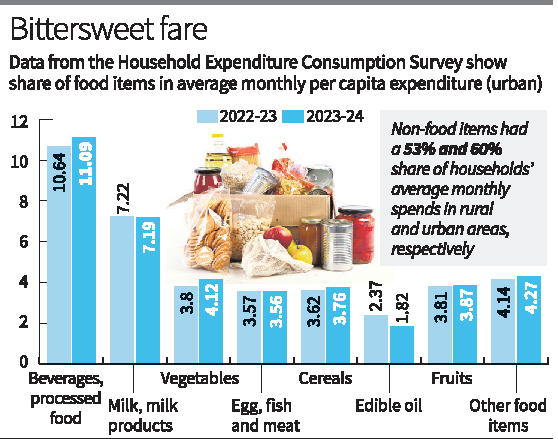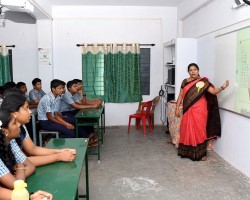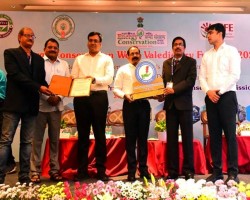Banking Current Affairs
TABLE OF CONTENTS |
| Polity and Governance |
|---|
|
|
|
The Smart Cities Mission (SCM), launched by the Ministry of Housing and Urban Affairs in June 2015, has been instrumental in modernizing urban education infrastructure through initiatives like smart classrooms and digital libraries. A recent study by the Indian Institute of Management, Bangalore, highlights the significant impact of these initiatives.
Key Highlights Smart Classrooms Initiative: Impact on Enrolment: A 22% increase in enrolment in government schools between 2015-16 and 2023-24, as reported by 19 cities. Scale of Implementation: 71 cities developed 9,433 smart classrooms across 2,398 government schools. Top States: Karnataka leads with 80 smart classroom projects, followed by Rajasthan (53), Tamil Nadu (23), and Delhi (12). West Bengal is among the lowest, with only 2 projects. Teacher Feedback: Teachers report improved learning experiences and attendance due to smart classrooms. Special training enhanced teachers' comfort in using smart classroom technology, with senior secondary teachers showing the highest preference. Digital Libraries: Infrastructure: 41 cities developed 7,809 seats in digital libraries. Notable Examples: Cities like Raipur (Chhattisgarh) and Tumakuru (Karnataka) have significantly supported students preparing for competitive exams through digital resources. Smart Cities Mission Overview: Objective: Promote cities with core infrastructure, a decent quality of life, and a clean, sustainable environment using "smart" solutions. Progress: As of November 2024, 91% of projects under SCM have been completed. SAAR Initiative (2022): Platform to bridge academia and government for urban innovation research. 50 impact assessment studies initiated under the “Sameeksha Series,” involving: 6 Indian Institutes of Management (IIMs). 8 Indian Institutes of Technology (IITs). 3 Schools of Planning and Architecture. 12 specialised research institutes. Significance Educational Transformation: Smart classrooms and digital libraries are enhancing access to quality education and improving enrolment in government schools. Capacity Building: Teacher training initiatives are fostering the effective use of digital tools, aligning with modern educational standards. Urban Development and Education. Integration of education reforms into urban planning reflects the mission's holistic approach to development. Challenges Unequal Distribution: States like West Bengal have limited smart classroom projects, indicating potential disparities. Sustainability: Long-term maintenance of infrastructure and digital resources remains a challenge. Way Forward Focus on Lagging States: Ensure equitable implementation across all States, especially those with fewer projects. Enhanced Collaboration: Strengthen the SAAR initiative to include more research and feedback from local stakeholders. Sustainability and Scalability: Develop strategies for sustainable operations and expansion of smart classroom initiatives. |
| International Relations |
|
|
Key Points:
|
|
|
|
Parliament Dissolution: Collapse of the Coalition Government: Reason for Dissolution: Implications: |
|
|
|
Key Development:
The bald eagle, a long-standing symbol of the United States' power and strength, has been officially designated as the national bird of the country. This was formalized by President Joe Biden, who signed legislation amending the United States Code to rectify the absence of an official declaration. Historical Significance: Despite being widely recognized as a national emblem, the bald eagle had not been officially designated as the national bird until now. Cultural and Monetary Presence: 📍The bald eagle first appeared as a symbol on a Massachusetts copper cent in 1776.📍It has since featured on several U.S. coins, including the silver dollar, half dollar, quarter, and various gold coins known as the eagle, half eagle, quarter eagle, and double eagle. 📍The bald eagle's image is also present on military insignia, presidential flags, U.S. currency, and other official documents.Legal Protection: The bald eagle is protected under the National Emblem Act of 1940, which prohibits the hunting or selling of the bird. This legislation underscores the importance of conserving the species, which is indigenous to North America. Significance of the Declaration: The official designation corrects an oversight and reaffirms the bald eagle’s symbolic importance to the United States. The National Eagle Center praised the decision, stating that "no bird is more deserving" of the honor. |
| Economy |
|
|
|
The Household Consumption Expenditure Survey (HCES) findings for 2023-24 reveal important trends in India's economic well-being and consumption patterns:
Key Highlights: Increase in Household Consumption: Average household consumption expenditure on a per capita basis rose 3.5% in real terms from August 2023 to July 2024 compared to the previous year. This indicates reduced consumption inequality and a narrowing urban-rural gap. Monthly Per Capita Expenditure (MPCE): Rural MPCE: Increased by 3.53% to ₹2,079. Urban MPCE: Grew by 3.48% to ₹6,996. The urban-rural gap in MPCE declined further to 70% in 2023-24 from 71% in 2022-23 and 84% in 2011-12. Consumption Patterns: Non-Food Items: Account for the majority of expenditure, with a 53% share in rural and 60% in urban areas. Decline in spending on edible oils offset higher spending on items like vegetables amid high food inflation. Consumption Inequality: Gini coefficient (a measure of inequality): Rural areas: Declined from 0.266 (2022-23) to 0.237 (2023-24). Urban areas: Declined from 0.314 (2022-23) to 0.284 (2023-24). The bottom 5%-10% of the population saw the highest increase in MPCE in both rural and urban areas. Poverty and Inflation Insights: Findings contribute to updating the Consumer Price Index (CPI), aiding in poverty estimation and tracking retail inflation trends. Survey Coverage: Data collected from 2,61,953 households across India, with 59% from rural areas. Significance: The results reflect improvements in economic equity, narrowing disparities between urban and rural consumption levels. They emphasize the resilience of rural consumption and the growing focus on non-food expenditure. The decline in the Gini coefficient underlines a reduction in income inequality. This survey is critical for policymakers to design welfare programs, fine-tune inflation measures, and assess the socio-economic impact of government schemes. |
|
|

|
| Science and Technology |
|
|
|
Innovation: Researchers at IIT Bombay have developed a needle-free “shock syringe” that uses high-energy pressure waves (shock waves) instead of needles to deliver drugs painlessly.
Mechanism: Utilizes shockwaves traveling faster than sound to create a microjet of liquid drugs. The device, slightly longer than a ballpoint pen, has a micro shock tube with three sections: driver, driven, and drug holder. Pressurized nitrogen gas generates the microjet, which penetrates the skin gently and rapidly. Key Benefits: Pain-Free Delivery: Patients do not feel the injection. Safe and Precise: Monitored pressure minimizes tissue damage. Cost-Effective: Capable of over 1,000 shots, with only the nozzle needing replacement. Prevents Needle Injuries: Reduces risks of blood-borne diseases due to mishandling of needles. Improves Immunization Drives: Especially useful for children and large-scale vaccination programs. Significance: This innovation could revolutionize healthcare by enhancing patient comfort, safety, and efficiency in drug delivery. |
|
|
|
Key Highlights: Overview of the Outbreak: Rwanda’s Response Measures: About Marburg Virus Disease (MVD): Recent Advances in MVD Management: Significance of Rwanda’s Efforts: |
| Awards |
|
|
|
Key Highlight:
Rashtriya Ispat Nigam Limited (RINL), the corporate entity of Visakhapatnam Steel Plant, has been awarded the Gold Award in the State Energy Conservation Award 2024 competitions. The award was presented by the State Energy Conservation Mission of Andhra Pradesh for RINL's exceptional efforts in Energy Conservation in the Iron & Steel sector. Award Details: 📍The award was received by Sri Uttam Brahma, GM (Energy, Environment & Utilities), and Sri VVVS Pulla Reddy, DGM (Energy Management Department), from Sri K. Vijayanand, IAS, Special Chief Secretary (Energy), Government of Andhra Pradesh.📍The ceremony took place during the Energy Conservation Week valedictory celebrations held in Vijayawada. Reasons for Recognition: RINL was honored for its innovative energy conservation initiatives implemented over the past three years, particularly for harnessing waste energy effectively. This achievement underscores RINL's commitment to sustainable practices and energy efficiency. Significance: 📍Boost to Sustainability: The award reflects RINL's leadership in adopting sustainable practices in the energy-intensive Iron & Steel industry.📍Acknowledgment of Excellence: This recognition enhances RINL’s reputation for its consistent contributions to energy management and environmental stewardship. |
|
<< 27-Dec-24
|
|
|







